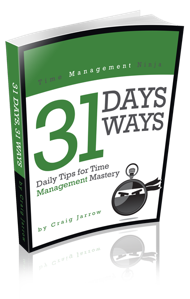
“I don’t have enough time.”
I hear this statement often. Often the perceived lack of time is the result of disorganization and poor time management.
But, what if you are right?
Maybe you don’t have enough time.
How would you know if you simply have too much to do?
Are You Overcommitted?
Do you know how many obligations you have? Many people who find themselves drowning in their responsibilities are unaware of just how many things are on their plate.
Examples:
- Client that realized they had 13 collateral duties at work. This was in addition to their job.
- Family with 3 kids that has 10 sports activities to keep up with.
- Colleague who after adding up their work, personal, and community volunteering, was committing to over 120 hours a week!
So, if you are finding that you don’t have enough time, you need to get better insight as to what is on your list.
Exercise: Build Your Commitment List
Today’s exercise is very simple, but don’t underestimate it. To build your “commitment list” you need to list your obligations from all areas of your life.
Most people think this is an easy task. “Of course, I can list them… I only have a few.”
Not so fast.
It is easy to overlook or downplay ones that do not seem important. But keep in mind that even the smallest obligations add up quickly in the big picture.
You may think that a once a month PTA meeting is simple enough, but add that to 3 kid’s sports, your personal hobby, and volunteering at the local shelter and you will soon find that your calendar has more colors on it than the big box of crayons.
Like a checking account, your time has a balance. You must keep a budget if you are to stay within that balance.
So, let’s get started and list all our commitments…no matter how big or small.
Here are some areas to consider:
- Work – Job, Collateral duties, other functions, work that you must bring home
- Life – Family, homework, kids activities, sports, school, housework, lessons
- Community – Church, Cub Scouts, volunteering, PTA, helping others
- Other – Home-owner’s Association? Hobbies? Etc.?
When listing your commitments, make sure you list an expected frequency/duration. If the sports are 2x a week each, list that. If your volunteering is 2x/month, note that.
A great way to get a 10,000 foot view of your commitments is then take your list and plot it on a monthly calendar. This does not have to be a true by date representation, but you will quickly see that if you have 3 kid’s sports 2x a week, plus your own Tennis league, plus volunteering… that, well, there are only so many days on your calendar.
How Many Did You Have?
After completing this exercise, most people are surprised at how many things are on their commitment list.
Once you are aware of all of your obligations, you can then make informed decisions about what to do and what to scale back on. You will know when your plate is full and know when you can say yes or no to new commitments.
And as a famous slogan says, “Knowing is half the battle.”
How many commitments are on your list? When have you had to scale back your obligations to keep things within your time budget?
Related Posts:
 I am the author of Time Management Ninja and help individuals and companies reclaim their time to be more productive. As well, I am the author of the book
I am the author of Time Management Ninja and help individuals and companies reclaim their time to be more productive. As well, I am the author of the book 

I often see clients who are constantly overwhelmed and don't know why. I hear “But my kid has to play a sport and an instrument, and if I don't step up, who will.” When they go through the exercise as you describe, they often realize that the original intention of getting involved in something (because they were interested in a sport or they felt the need to give back) is often lost in a sea of overwhelm.
Lori K.- Professional Organizer
Very good thoughts here, Craig. This is somewhat like Covey’s list in “7 Habits”. We just don’t get that we overcommit. Thanks for the encouragement.
Thanks , I’ve just been searching for info about this topic for a while and yours is
the greatest I have discovered so far. However,
what concerning the bottom line? Are you certain about the
supply?
I really like the kind of simple written article so people can understand it and people can understand what message the author wants to convey. Your style is very unique but it’s easy to understand what you want to say in this discussion.